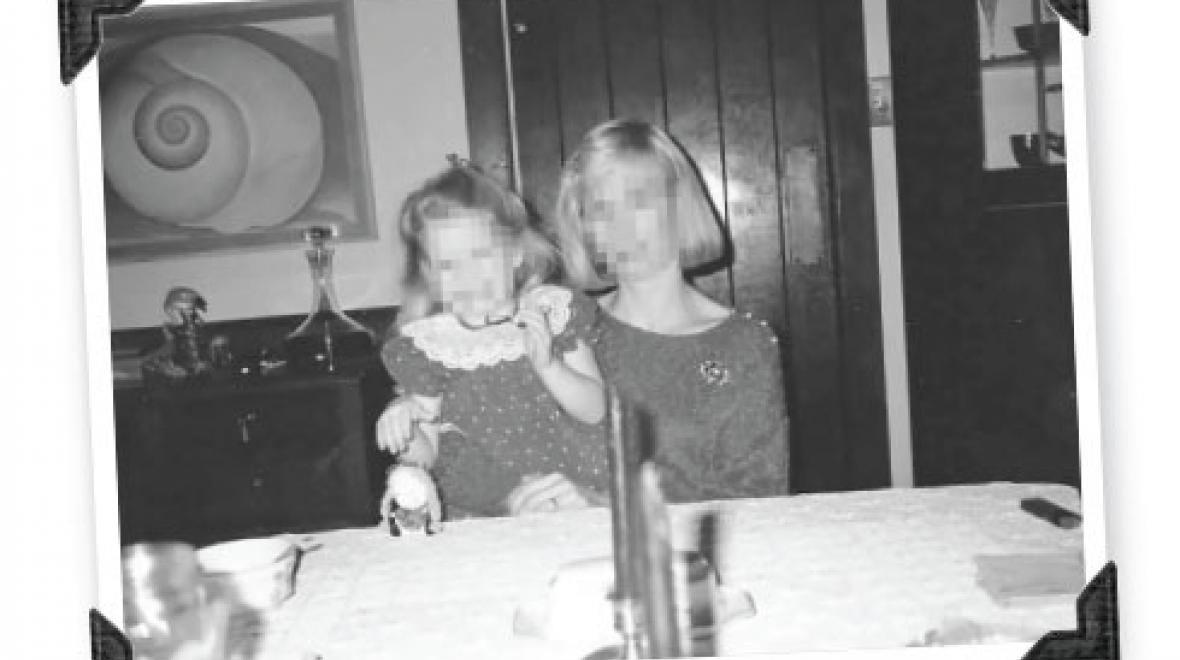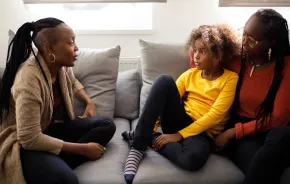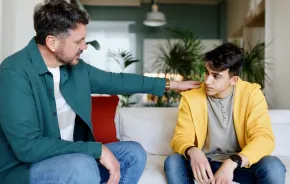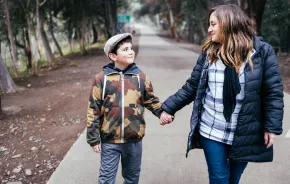
It was the phone call that I had been dreading.
“Your mom is in the hospital. John* shot her,” said my Aunt Lauren*.
I felt like someone had slugged me in the gut. The questions poured out of me along with the tears: How bad was it? What condition was she in?
Some part of me, the part that prefers optimistic naivety over hard truths, had been hoping that I’d never have to take this call. The rational part had been expecting it. I’d become adept at picking out certain parts of a pattern over the years, and this was the next piece that makes up the ugly fabric of domestic violence.
My aunt handed the phone to my mother, who talked in the sugary, soothing voice she uses whenever she reassures me that she is “fine.” I’ve always known that she’s lying when she uses that tone.
“I’m fine, sweetie! It could have been so much worse. I just wanted to wait until I was stable enough to tell you so you didn’t have to worry. Everything is going to be just fine. It’s just my foot.” I soon learned that it actually had been days since she arrived at the hospital.
I wanted to hold her hand, to hug her. Instead, I sobbed as she quickly came up with an excuse to hang up the phone. She had been dreading this phone call as much as I had.
Our previous conversation hadn’t ended well. A year before, I’d learned that her husband had been arrested for strangling her and threatening her with guns. They had since reconciled and were living together. I’d yelled at my mom, told her that she was being stupid and reckless. I’d pleaded with her and threatened to stop speaking to her. Nothing worked. She’d spent their entire 20-year marriage defending my stepfather, while my brother and I had spent most of our childhood resenting her for it. It was a bitterness that seemed to taint even the sweetest moments.
And now my mother had become the victim of a crime that is the leading cause of injury to women. While mass shootings garner headlines, paralyze us with fear, and fuel debate on gun issues, many more people are likely to be affected by domestic violence. Statistics show that one in four women will experience domestic violence in her lifetime.
Between January 1, 1997, and June 30, 2010, in Washington state alone, there were 463 homicides committed by domestic-violence abusers, with more than half of the victims killed with firearms, according to the Washington State Coalition Against Domestic Violence (WSCADV). In the cases where the victim had children, 55 percent were present at the scene of the homicide; 16 children were killed.
Domestic violence also plays a role in mass shootings. A study by Mayors Against Illegal Guns of every identifiable mass shooting (shootings in which four or more people are murdered) between January 2009 and January 2013 found that 57 percent of the incidents involved the killing of a family member, or a current or former intimate partner, of the shooter.
What if my own young children had been near my mother when John shot her? What if the damage had been even worse?
Instead, for us, my mother’s gun attack was both the culmination of years of fear and denial and the beginning of a powerful transformation for our family.
‘Normal’ from the outside
I was 7 when my mom began dating John. After a brief courtship, they were married. Suddenly, our home felt like a strange dictatorship. The rules were unpredictable and changed with John’s whims. My brother was nicknamed LB, short for “lead butt,” and I became “the ’tard,” short for “the retard.” If we didn’t wake up before 6:30 a.m. each morning, he sprayed us with a water cannon. If our showers took longer than three minutes, he shut off the water to the entire house and we were left with soapy hair and burning eyes. I found myself sometimes using the garden hose to wash my hair.
A common myth about domestic violence is that it’s only prevalent among those who are uneducated and living in poverty. John was extremely intelligent: He read books on abstract mathematics and had a master’s degree in engineering. My mom held an MBA and earned two more masters’ degrees during their marriage. From the outside, we probably seemed perfectly normal. We lived in an upscale neighborhood. We attended church.
John collected guns. They were laid out meticulously in rows on the floor of the living room, boxes of ammunition stacked nearby. Dozens of “sharp shooter” trophies, from his time as a police reserve officer, were displayed on a shelf. There was a scar from a bullet on his ankle. When I asked about it he grew quiet and sulky, so I learned to avoid the question. Years later, I found out he had shot himself accidentally.
He liked to conduct target practice on the television with the laser sights on his gun. A Republican, he would pull out his gun when President Bill Clinton was on, cursing as he fired his unloaded weapon, the sight on Clinton’s head. The “click, click, click” of the gun was always a warning that he was in a bad mood.
Through the years, John became more controlling and violent. We all learned to tiptoe around him, to try our best to go unseen and unnoticed. My brother and I cleaned the house frantically when we knew he was on his way home, desperate to mitigate anything that would trigger his anger.
He found ways of justifying any physical abuse. “I wasn’t pulling your hair, that’s called a hair hold. It’s what we’d use on criminals when we’d arrest them,” he’d say, referencing his officer experience.
Years of abuse warps people. Abusers know this. They start off charming and loving, but slowly peel away the self-worth of their victims like the layers of an onion. That’s how they get them to stay. Sometimes, my mother will sigh to herself and say wistfully, “I used to be funny. I could tell good jokes and make people laugh. I feel like I’ve lost that.” I long to tell her that she didn’t lose it, it was taken from her.
My mother’s experience isn’t uncommon, and the toxic mixture of domestic violence and firearms made her particularly vulnerable. According to the Centers for Disease Control and Prevention (CDC), an estimated 1.3 million women in the U.S. are victims of a physical assault by a partner each year. When guns are a part of the equation, the risk of homicide skyrockets to more than five times higher than in instances where there are no weapons.
The WSCADV put together a list of 11 recommendations after reviewing 13 years of domestic-violence fatalities. One of those recommendations is to “maximize the use of existing legal means to restrict abusers’ access to firearms,” citing numerous cases where the state’s failure to do this resulted in homicide.
A hard recovery
I would learn that my mother nearly bled to death after John shot her through the foot with a .45-caliber bullet, blowing off some of her heel and leaving her with a permanent limp. They were struggling over the gun when it went off. According to my mom, he attacked her, punched her, choked her and pinned her to the ground, then reached for the gun. She tried to knock it out of his hand when it went off. He’d left her bleeding on the ground while she begged for him to dial 911. John paced the house following the shooting. She doesn’t know how long it finally took him to phone for an ambulance because she was in and out of consciousness.
Police charged the house, weapons ready, and took him into custody. As the medics tended to my mother, the police drilled her with questions that she couldn’t answer because she was too disoriented. They wrote that she was “uncooperative” on the police report. Later, they would use her case as an example for training officers on how not to handle a domestic-violence incident. She was taken by Life Flight to a nearby city.
Months of surgeries followed. She was in and out of the hospital. We set up a bunk bed in my son’s room for my two older kids and moved my mom into my daughter’s room. Hospice care nurses were in and out, dressing her wounds and checking her vitals. She wore a wound pump on her foot, which made a strange gurgling noise as it kept fluid from pooling in the hole in her foot. Recent MRI scans have revealed that she has some brain damage, likely from lack of oxygen to the brain due to traumatic blood loss. The brain damage has affected her ability to effectively do her job and to remember things.
Her wound eventually became septic. She looked so frail and pale, I worried she was dying slowly. When I visited her at the hospital, they made me wear a mask, gloves and a gown. I wanted to hug her and hold her hand, but it felt alien through latex gloves and papery robes.
She asked me to wash her hair once while I visited. She had always been one of those put-together ladies — coiffed hair, perfect makeup, trendy outfits. I thought of all the ways that her pride had been stolen from her as the nurse and I lathered her hair with soap and water that we squirted from plastic squeeze tubes, letting it drip into a garbage can beneath her head.
Police seized 24 guns and hundreds of rounds of ammo from my mom and John’s home after the shooting. Unless new legislation passes in our state, my mother may have no legal recourse for ensuring that John doesn’t get his guns back.
From pain to power
Her voice shakes and she looks fragile, but I can see the fierce determination in her eyes. It’s the same stubbornness that I faced when I told her I wanted to drop out of voice lessons as a teenager.
“Hello Chairman Patten and members of this committee. My name is Jodie Marsh*, and I am here to testify in support of Substitute House Bill 1840 ...”
It’s a strange meeting in our statehouse on this March day in 2013, filled mostly with monotone legislator speeches on something so profoundly sad and painful that it feels awkward. Substitute House Bill 1840 deals with two issues that, statistically, go hand-in-hand: Protection orders and gun violence. When protection orders are issued, it is a dangerous time for those seeking them. SHB 1840 would ban people under full protection orders from buying or owning weapons while that order is in place.
Resources
- National Domestic Violence Hotline: 800-799-7233
- The Northwest Network of Bi, Trans & Lesbian Survivors of Abuse: 206-568-7777
- King County Sexual Assault Resource Center: 888-998-6423
A New York Times investigation by Michael Luo on protection orders, gun rights and state laws includes compelling data that illustrates why this legislation is sorely needed in Washington state:
“By analyzing a number of Washington databases, The New York Times identified scores of gun-related crimes committed by people subject to recently issued civil protection orders, including murder, attempted murder and kidnapping. In at least five instances over the last decade, women were shot to death less than a month after obtaining protection orders. . . . There were dozens of gun-related assaults.”
My mother stands before the committee, under the dome of the capital building, looking small while trying to do a very large and important thing. She was released recently from a month-long hospitalization due to a septic MRSA infection in her gunshot wound.
“Mom, just stay home and rest. You need your strength,” I had told her, exasperated.
She set her jaw and, with that familiar fierceness, said, “Sweetheart, the only thing that will keep me from speaking at this is death. I want something good to come of this mess.” With that, she ceased taking her pain medications so that she could drive herself hours to Olympia.
She’s not the only gunshot victim who testifies on behalf of the bill. Courtney Weaver, shot in the face by her partner in a domestic dispute in 2010, stands before the Senate Committee on Law and Justice her beauty apparent despite a jagged scar across her right cheek. She holds a photo of her injury when it was freshly inflicted, half of her face an unrecognizable jumble of blood and flesh, and asks, “I just wonder how many martyrs are going to have to die before action will be taken to enforce this protocol where firearms are seized?”
Seeking full protection
Washington state is not the only place where gun rights trump or hamper protection laws.
The New York Times investigation reveals how, in most states, civil protection orders do not require the person served to give up their guns, in large part due to the influence of gun-rights groups. There is already a federal prohibition banning people subject to full protection orders from buying or owning weapons. SHB 1840 seeks to emulate the federal language. Currently in our state, there are no legislated protocols for removing and storing firearms.
When SHB 1840 was first introduced, the National Rifle Association (NRA) lobbied to amend the bill in a way that supporters claimed would render it pointless, but House Democrats banded together and passed it with a 61–37 vote. The bill has since been sent back to the Rules Committee three times for revision by the Republican-led majority caucus in charge of the Senate.
The bill did not pass the Senate before the end of the regular session. It may be re-voted on by the House as soon as January. I spoke with the bill’s prime sponsor, Rep. Rogert Goodman, D–Kirkland, who said he was “cautiously optimistic” that it would then pass in the Senate.
Rep. Jamie Pedersen, D–Seattle, another sponsor of the bill, told me that he thinks SHB 1840 has the potential to prevent more gun violence than almost any other bill that was considered last session, and he hopes that the Senate will take action on it.
If state history is any indication, though, things aren’t looking too promising. In 2004, a bill mandating the surrender of firearms with temporary protection orders failed to make it out of committee after strong lobbying against it by the NRA. Another proposal requiring surrender only after a full protection order was issued failed in 2010.
Meanwhile, gun-safety and victims-rights advocates are pressing for change on multiple fronts, and gun-rights supporters are fighting back.
Initiative 594, backed by the Washington Alliance for Gun Responsibility, seeks legislation that would require anyone buying a gun in Washington state to pass the same background check, no matter where they buy the gun and no matter from whom they buy it. Currently, loopholes allow firearms to be sold between private sellers and at gun shows without criminal background checks.
In response, gun-rights advocates have proposed legislation that would essentially render useless much of the gun-responsibility legislation currently under consideration. Initiative 591 would prevent Washington state from adopting background-check laws more restrictive than the federal standard and would prevent confiscation of firearms without due process. This is especially bad news for victims of domestic violence.
Both groups must collect and submit enough petitions by January 3. If they do, lawmakers can adopt the measures during the next legislative session, otherwise the measures would go to voters in November 2014.
Having grown up in Idaho, I understand that many of the people opposing gun reform are genuinely concerned about protecting their personal freedoms. My conservative hometown just outside of Boise is full of people who take their Second Amendment rights very seriously — responsible gun owners, hunters and gun enthusiasts. I stand behind their right to bear arms. Gun-responsibility legislation will not affect the rights of law-abiding citizens. It will only ensure common-sense protocols to keep guns out of the hands of potentially dangerous people.
It’s easy to write off violent shooting incidents as flukes, to assume shooters are lone wolves whose actions can’t be mitigated. In a clumsy grasp for justice, in a situation that is so profoundly unjust, the vitriol over gun legislation has morphed into sound bites and party lines. Research shows again and again how this kind of gun-responsibility legislation has helped to reduce gun-related homicides and create safer communities.
But there are heroes out there among us. Heroes like Shannon Watts, founder of Moms Demand Action for Gun Sense in America. The Indiana mother started a Facebook page after the Sandy Hook shootings and is now leading a crusade in our country for gun responsibility, which most recently resulted in Starbucks CEO Howard Schultz requesting patrons not carry weapons in the company’s stores. Heroes like Cheryl Stumbo, who survived the 2006 shooting at the Jewish Federation of Greater Seattle and now advocates for increased gun-safety measures; heroes like Courtney Weaver.
Heroes like my mom, who drives across the state after being released from the hospital, in pain, to tell her story.
I want to know that my mother doesn’t have to worry about her ex-husband getting his guns back. I want to send my son off to school, confident the loopholes that allow people to buy guns legally from private sellers and gun shows without background checks have been closed. I want domestic-violence victims who seek protection orders to find comfort in the knowledge that guns could be removed from the equation.
I want to know that I live in a state and country that don’t stand idly by while gun violence takes more lives.
Editor's note: Some names have been changed to protect those affected by domestic violence
What more can you do?You've had ENOUGH and so have we. Every month, we're sending out updates with the latest news, resources for your family and actions items to get involved in the movement. Sign up now. |











